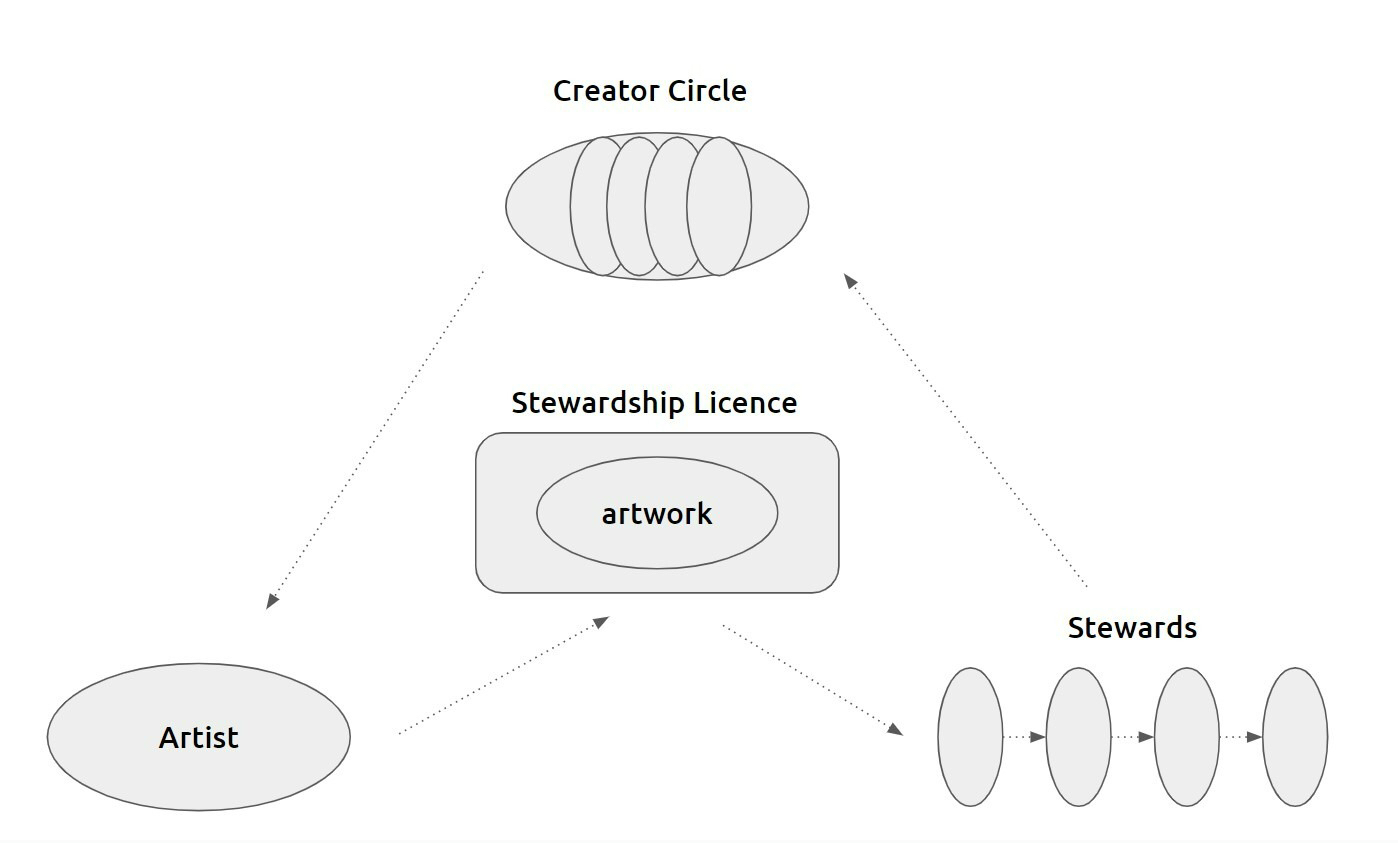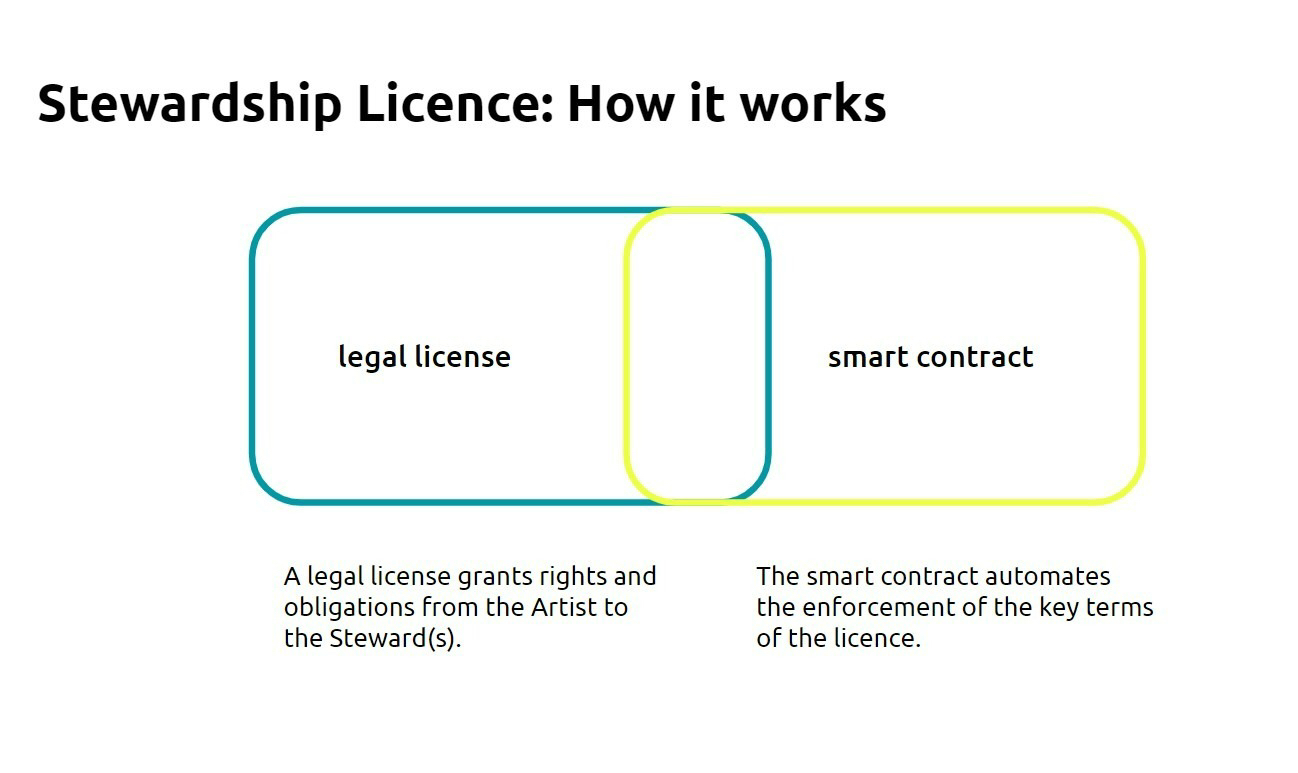Partial Common Ownership of Art
Art enriches society through the weaving of relations between the cultures that create it and the cultures that receive it. Partial Common Ownership of Art (PCOArt) is a new evolving system that allows artists, communities and holders of art to create structures of shared ownership and distribution of value that reflects those living relationships.
Actors
Partial Common Ownership of Art recognises that art and art’s value emerge from the ongoing interactions between artists, communities, organisations, and wider societal dynamics. PCOArt allows artists to embed the individual commitments their art may have to specific communities, causes and organisations into the ownership and value distribution model that underwrites the circulation of their work. Contrary to the traditional ownership model that privileges a single creator (the artist) and an exclusive owner of art (the collector), PCOArt offers a system for recognising the legal and economic status of a plurality of stakeholders and thus allowing art to perform its values not just symbolically but also operationally and materially.
PCOArt incorporate three core stakeholder roles:
-
Artist(s): the instigators and authors of the artwork;
-
Creator Circle: the individuals, entities and/or communities that are integral to the creation of the work either by supplying inspiration and context for the artwork, and/or contributing informal or invisible labour to the artwork, and/or participating in producing and maintaining the artwork;
-
Steward: the supporters of art for whom possession of the artwork is a reflection of their commitment to the Creator Circle cause(s) as well as the artwork itself.

Core Mechanisms
PCOArt introduces a set of new social and economic mechanisms that are distinct from familiar patterns such as absolute ownership, fractional ownership, collective ownership and renting/leasing. Here is how it works:
- Stewardship Licence (SL) allows Artists and the Creator Circle to define how they’d like the stewardship structure to reflect the values of their artwork.
The Artist and the Creator Circle create a Stewardship Licence for their artwork to enter circulation. In the SL, they define who is part of the artwork’s Creator Circle. These may include the artist themselves, as well as key actors in the community around them – their studio members, the people, places, and institutions whose energy is reflected in the work.
The SL also defines the duration of Stewardship Cycle(s), an honorarium to be paid out to the Creator Circle by the Stewards during that Cycle, and any additional governance terms, such as who can and cannot be a Steward.
When the SL passes into the hands of a Steward, they have various rights relating to the artwork and its context(s). They also become responsible to the artwork’s Creator Circle – for example, the Steward may be required to follow certain simple guidelines in exhibiting and/or maintaining the artwork. They may also benefit from being connected to the Creator Circle socially and organisationally.
- Stewardship Cycles introduce a new logic binding possession of art with a commitment to art as an agent of positive societal change.
Through the SL the Artist defines the period of time that each Stewardship Cycle lasts. At the end of each Stewardship Cycle, the incumbent Steward can either recommit to the artwork or the SL will pass on to a new Steward. While possession of the SL and the artwork that it points to are temporary, each Steward will forever remain part of the networked community grown through the artwork’s circulation.
- Stewardship Inaugurations are a periodic occasion for the artwork’s Stewardship Licenses to re-enter circulation, thereby allowing Stewards to either recommit or for the artwork to pass to a subsequent Steward.
At the end of each Stewardship Cycle, new eligible potential Stewards have an opportunity to obtain it at a Stewardship Inauguration.
If a Steward in one Stewardship Cycle ceases the stewardship of the next cycle, they receive a portion of any payment from the new Steward. The rest of the payment by the new Steward flows to the Creator Circle.
A Steward who renews their stewardship for a new cycle only pays an Honorarium to the Creator Circle.
- Periodic Honorarium is the percentage of the price of the Stewardship License that passes on to the Creator Circle at each Stewardship Inauguration.
The percentage of the price that is due to the Creator Circle at the outset of each new Stewardship Cycle is set by the Artist (and/or the Creator Circle) as part of the SL.
By arranging the rights of an art ecosystem in this way, no one has an absolute ownership interest. The work is managed as a shared project by a network of aligned actors.
Infrastructure

While the minimum PCOArt infrastructure is simply customising a Stewardship License to the needs of a project, the PCOArt system can greatly benefit from the use of blockchain technology to instantiate the Artist - Creator Circle - Steward roles. This helps automate what can otherwise be a complex set of administrative processes. A PCOArt smart contract system that integrates and enforces the key terms of the Stewardship Licence allows for the periodic Stewardship Inaugurations, and remittance of fees to the Creator Circle, simply to run themselves.
There is, however, undoubtedly a need to nurture an off-chain ecosystem of PCOArt mission-oriented organisations that can socially embed and evolve this foundational system into context-specific branches and iterations.
Use Cases
- Where artistic practice is highly networked and/or relies extensively on collaborations
As Future Art Ecosystems briefings have shown, artists working with advanced technologies almost always work in highly collaborative settings, leveraging specialist know-how and relying on teams in the production of their artworks. While artists are increasingly crediting what used to pass as ‘invisible labour’, the long-term sustainability of their studio models requires a reliable and consistent source of income.[1] As the question of maintaining studios and critical collaborations is not unique to artists working with advanced technologies, the PCOArt model is equally relevant to all artists whose Creator Circle is central to their practice from ideation and production stand-points.
- Where artistic practice is thematically and socially entangled with communities and organisations engaged in larger critical societal struggles
Whether it’s the perversity of economic logics that lead to wealth inequality, or shining light on abuses of power and outright crimes with grave social and environmental consequences, or proposing new perspectives in a conversation dominated by narrow lenses, many artists today are deeply committed to serving wider causes through their art. However, once these artworks become assets for purchase with an exclusive ownership right, they lose their latent potential to serve the causes that (at least in part) define them. The reason this has become the status quo is because there have been no good models for leveraging market activity within the art field to translate commitments to specific causes into legally recognised interests and material benefits. PCOArt allows for that to happen.
- Where specific requests relating to how the work should be handled and maintained are core to the Artist’s and Creator Circle’s wishes
Many types of art (performance art, AxAT, socially engaged art) are poorly suited to traditional ownership models. Consider, for example, complex media installations and interactive works. To keep such works vital, specific types of commitment that are best executed on a temporary basis might be required. PCOArt reconfigures what it means to ‘possess’ an artwork, helping to align the interests of the Artist, the Creator Circle and the Stewards.
Fairclouds: PCOArt with Aerocene Foundation
How to Get Involved
The PCOArt project is initiated and incubated by RadicalxChange and Serpentine Arts Technologies (Future Art Ecosystems), and developed in collaboration with Aerocene Foundation, with technical support from Graven Prest, Cody Hatfield and Stefano De Berardinis, and advisory support from Will Holley and Lucy Sollitt.
Please get in touch if you are interested in proposing a project for the PCOArt system.
Further Resources
RadicalxChange(s) podcast episode on art & infrastructural experimentation
Partial Common Ownership wiki page
Notes
Previous attempts to ensure that artists receive a fair share of long-term increases in the value of their work have faltered. Resale commissions, for example, are hard to enforce, especially internationally. Even when they are respected, they put artists in an entirely passive role, with no ability to influence how the work is stewarded, and give the vast majority of future value increases to downstream owners. Partial common ownership automates remission of the creators’ interests, builds in a relationship between the artist and the steward, and retains for creators the majority of the ongoing value of the work. ↩︎